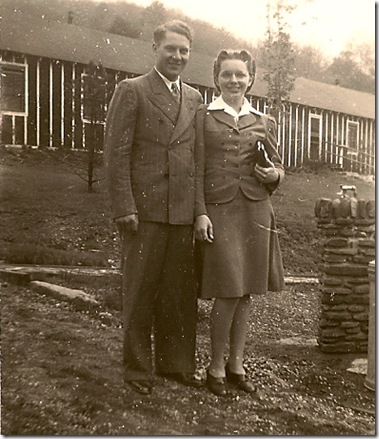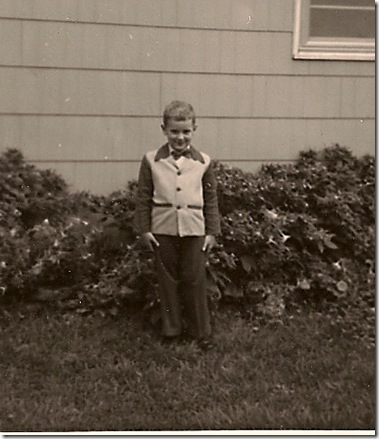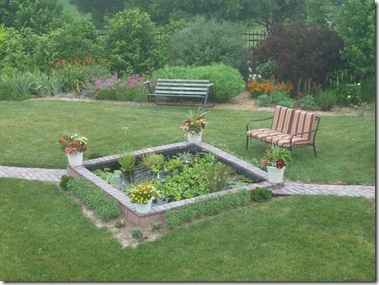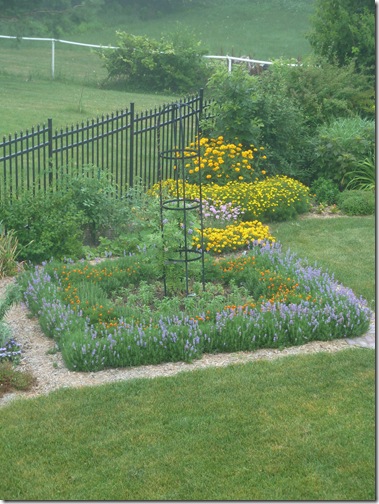I was lucky enough to spend time with Denny Schrock a few years ago on a trip to Holland for gardening journalists. I quickly discovered that he is a multi-talented individual filled with curiosity, a plethora of knowledge on a wide variety of subjects, and a gentle and humble soul.
Denny has been with Meredith Publishing for 9 years. He has edited over 30 books and provides garden content for Better Home and Garden’s website and the digital edition of their magazine and has a Doctorate in Horticulture from The University of Minnesota.
He describes himself as a plant nerd with a low-maintenance landscape that features more than 1500 different perennials, trees, and shrubs on his half-acre in suburban Des Moines.
This is Denny’s story about his mother.
About what she taught him in the garden and life.
I hope you enjoy it as much as I have. Fran Sorin
Did your mother pass down any stories about herself, family members, neighbors, etc. that have to do with gardening?
My mother wasn’t much of a storyteller. I think it mostly had to do with her busy life, raising 6 children, trying to eke out a living on our farm. Mornings started for her at 6 a.m., when she would wake up the boys to go out and help Dad with morning chores. (He was up at 4:30 or 5:00 to start milking the cows.) The boys would finish the morning chores while Dad left to make the rounds with the school bus. We were the last to be picked up on the route. After school, Mom always had several piano students to give lessons to before evening chores.
 |
| Denny’s Mother and Father |
If your mother worked in the garden, what did she teach you about gardening?
We had a huge vegetable garden (about ½ acre, plus sweet corn in fields). We produced and preserved virtually all the vegetables that our family ate throughout the year. Our house was literally built around a huge double wide upright freezer into which much of the produce went. We also had 5 shelves of canned goods in the basement, 20 feet long and 3 feet deep. In addition, our root cellar was filled every fall with many bushels of potatoes, onions, and squash.
Mom was certainly involved in planting, weeding, and harvesting of the garden, and I’m sure that I learned a lot from her by example, however, I’d say that my Grandma Geyer (my mother’s mother) taught me more about growing plants. Mom’s expertise was more along the lines of food preservation. It was from her that I learned how to can, freeze, and otherwise preserve produce.
Mom did encourage my interest in plants. She would let me pour through the seed catalogs and help make selections of what we would grow for the coming year. As a kid of 5 or 6 years old, I was able to purchase the 1-cent kids packet from Gurneys Seed Company. You never knew what seeds would be in the packet, but there was always an array of vegetable and flowers.
 |
| Denny- age 6 |
I had my own garden space set apart from the family plot, and it was my responsibility to care for the vegetables and flowers in the plot. This taught me responsibility (although I was always interested enough in gardening that I didn’t have to be told to do it! In fact, it was a form of relaxation for me, even at that early age. If I wasn’t working in the garden, I’d likely have to be baling hay, cleaning the barn, or doing some other chores that were much less to my liking.)
Gardening on the farm was mostly about food production, but Mom allowed me to dabble in ornamentals, too. I could always try a new flower or two in the annual seed order.
If not, was there one person or a few individuals that did teach you about gardening? What did they pass onto you?
I mentioned that my Grandma had a strong influence on my interest in gardening. She spent hours on end in the garden weeding, planting, and harvesting. I was often by her side helping. From her I learned to distinguish vegetable seedlings from weed seedlings. I learned efficient methods of weed removal with a hoe (slice at ground level, don’t chop!). I learned the proper stage to harvest various vegetables and fruits. (We grew lots of raspberries and strawberries, too, and had several apple trees.) She liked to grow some heirloom plants that my parents never would have grown otherwise—for example garden huckleberry and cape gooseberry.
My Aunt Opal and Uncle Troy also had a strong influence on my horticultural interests and knowledge. Their farm was several miles away from ours, but we traded labor back and forth all the time. That meant that especially through the summer months, I spent a lot of time at their farm working in the fields. Both were avid gardeners. Troy concentrated on growing edibles, and Opal on growing flowers, although she was also a gourmet cook, so she had her herb garden and an extensive rose and perennial border. Both broadened my view of plants that could be grown, and encouraged me to try new things. I still vividly remember eating a green pepper for the first time at their dinner table. From then on, peppers became a standard part of our home vegetable garden, too.
 |
| New Water Garden built by Denny and Patrick |
What did your mother teach you in other areas of your life?
My mother was the queen of frugality! She saved and reused/repurposed everything. Our attic was full of hand-me-down clothes and other items that might someday have some use. Christmas wrapping paper was reused for several years, until it became tattered. From that I learned a respect for the value of things, and to not automatically throw things away. (We had no trash service in the country. All of our trash was burned in a 55-gallon drum. Kitchen waste was fed to the pigs.)
I also learned about false economy from her actions. She would drive from one store to another to save a few pennies on a particular advertised item, not stopping to think how much it cost in gasoline, wear and tear on the vehicle, and time.
Mom also was a champion for the underdog and those less fortunate. Our family never had much money, but the first priority from the check that came twice per month from the creamery for the milk that we sold, was a tithe to the church. And although none of us kids got an allowance as such, we were given calves as 4-H projects, and when they matured into cows, the proportion of the entire check that was attributable to our cows was given to us. (The amount was determined from the monthly visit from the milk tester, who weighed the amount of milk given by each cow, and tested it for quality, i.e. butterfat content.) Each sibling was expected to donate generously to the church, too. The rest went directly to our bank savings accounts. (Back to the frugality!)
Both parents taught me by their actions to be open and accepting of those who were different from us. I had an aunt and uncle who were missionaries in Nigeria for 50 years, so we had blacks visiting in our home ever since I was a little kid. This was quite an unusual experience for the average rural Minnesota kid in the ‘50s and ‘60s! My parents were also youth group leaders for our church. They took the youth group to visit services of other faiths, including driving us 45 miles to the nearest synagogue. My parents knew what it was like to be ostracized for their views. My Dad was a conscientious objector in World War II, which was a highly unpopular stance at the time. He performed alternative service rather than to go into the military.
How did your Mother live her life?
Mom lived her life caring for others. She didn’t often express her love in words, but it was clear that keeping her family well fed was her means of expressing her love for us. She grew up in the Depression, so, I think, always had scarcity mentality affecting her actions. It wasn’t enough to have sufficient food laid by, we had to have several year’s supply on hand.
Mom also lived her life fully in service to others. At various times she was church organist, choir director, election judge, representative to the church’s district and national conferences, and for the last 15 years of his life, caregiver to my father, who was suffering from a closed head injury that produced Alzheimer-like symptoms. After much urging from all of her kids, she finally agreed to place him in an Alzheimer’s unit. Unfortunately for her, she lived only a couple of months after that due to the development of a massive tumor and heart attack. As she lay in intensive care, she called me in and started to tell me where all of the important papers were for her and Dad because I had power of attorney for both of them. In typical fashion, she didn’t want to be a bother to anyone else, even in her death. Funeral arrangements were prepaid and all arranged ahead of time.
Do you think of yourself as creative? How does it come through in your garden and in life?
I do consider myself to be a creative person. It’s not that I have wildly different or unique ideas, but I love to create things of beauty and to craft words in clever ways. My life experiences are different from the average American, so perhaps I do see things in a different way from most. I like to surround myself with beautiful things, so I have an extensive flower garden. I also like to share the beauty with others. I do that through garden tours and photos that get published in books, magazines, and blogs.
Describe your own garden as you see/feel it. Do you think it reflects who you are?
I’ll defer to my husband, Patrick’s explanation of my garden style. He says that I prefer a jardin Anglais —large flowing borders bursting with perennials. That’s true, although I wouldn’t call my garden a cottage garden. It has much more order and control. (Which is definitely a reflection on who I am! At work, I’m known as the one with the cleanest office, most likely to be ahead of schedule on projects, and most likely to be able to find a missing memo or item because of my organized filing system.)
 |
| Herbal Knot Garden |
I have married English cottage gardening with the New American garden style and French formal gardening in my home gardens. Many of the plants that I use are native Midwest perennials. (I conducted research on landscape adaptability of many of these plants while teaching at the University of Missouri and University of Illinois.) I select dwarf varieties when available—to keep the garden tidy, of course! And although the primary bed structure consists of long sweeping curves, I’ve inserted geometric structure with a boxwood knot garden, herbal knot garden, diamond-shape patio and fire pit seating area, and rectangular raised bed vegetable gardens.
To me the result is a pleasant mix of structure, order, and free-flowing elegance. I like to keep the garden neat, tidy, trimmed, and weed-free, but I don’t want it to feel artificially structured, contrived or controlled.
 |
| Denny and Patrick with Katherine, their granddaughter |
Do you think of earth as Mother Earth? If so, what is it that she has taught you?
I believe in working with nature rather than against it. I try to understand the natural cycles of plant growth and decay, and plants’ interactions with pests. I’ve studied the science behind all of these processes, so I mostly know what is happening, even at a molecular level, but there’s still something magical about the first flowers of spring emerging from the ground.
From Mother Nature, I’ve learned patience. There’s no need to work too hard to create compost. It will happen on it’s own if only you’ll wait for natural organisms to do the work for you. I’ve learned to pay attention to weather patterns rather than the calendar for planting. Timing can vary by several weeks depending on the year.
To read the first in this series of What Our Mothers Taught Us About Gardening and Life with Rebecca Sweet, click here.
Please not: Fran Sorin, the editor of this series about our mothers, the author of Digging Deep: Unearthing Your Creative Roots Through Gardening, and the Producer of GGW, has created a new blog, www.AwakeCreate.com. Check it out, participate in its Facebook page …Awake Create. And if you like it, please like and tweet to friends. Thanks!
